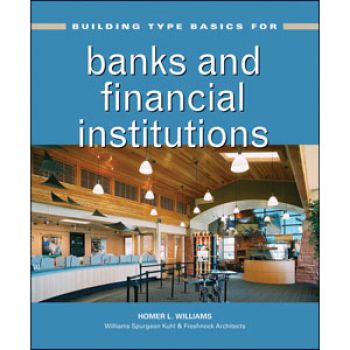Helpful Guide To Branch Building Basics
Book Review: Veteran of more than 100 financial office designs shares essentials for veterans and first timers alike
- |
- Written by James Donnelly
- |
- Comments: DISQUS_COMMENTS
 Building Type Basics For Banks And Financial Institutions, by Homer L. Williams, Williams Spurgeon Kuhl & Freshnock Architects, Inc. (WSKF), 256 pp., Wiley, 2010
Building Type Basics For Banks And Financial Institutions, by Homer L. Williams, Williams Spurgeon Kuhl & Freshnock Architects, Inc. (WSKF), 256 pp., Wiley, 2010
The institution I work for, Machias Savings Bank, is in “Downeast” Maine, where we have cold winters and pleasant summers. So, the chapters in Dr. Homer William’s guidebook to bank branch design that concerned employee comfort and windows really struck a chord with me.
In my time at the bank, I heard a story about an executive who was being driven crazy by employees who were too hot or too cold in their brand-new headquarters building. To cope, he finally installed thermostats in each office so each employee could adjust the temperature of their space to suit themselves. This solved the problem and allowed people to focus on their jobs.
Fast forward: The bank was sold to a larger competitor years later. As the acquiring bank’s team did their due diligence they discovered the executive’s little secret: The thermostats weren’t hooked up to anything! It was all working in their heads.
More cold comfort
Prior to taking my current position, I was in charge of five branches, developed four new branch sites, and assisted in the evaluation of a branch we acquired. This kind of experience gives one an appreciation of the many issues that go into branch design, and the comfort challenges involved.
Even today, I have a newer branch with large windows that is challenged by cold feet for some employees during our coldest Maine days. Some of the practical climate control advice in Building Type Basics For Banks And Financial Institutions deals with putting a small zone of heat under those large windows to offset their cooling effects. A simple and almost obvious solution, once pointed out, but it provided this reader with an “ah ha” moment.
If you face such situations, you may find value in this book for that one very important detail that will save you from the banking executive’s solution of “mind over matter” or making a small mistake in design that costs you productivity.
Wide-ranging approach to design
Banking offices serve many purposes today besides simply housing banker bodies and a vault. The book’s blending of the critical issues of a branch’s facets, including marketing, branding, employee and customer comfort, and architecturally pleasing design underscores the challenge. The book’s inclusion of discussions of those issues, plus tools such as checklists for starting and completing projects, and finishing with floor plans with case studies, makes this book a great reference tool. I see Williams’ book as a helpful aid to working bankers and a must-have for future banking school curriculums.
This book would be especially useful to new facilities people. It carefully winds its way through the topic of facilities, while adding the historical context of construction periods and various architectural innovators in our industry. The author also weaves in the regulatory issues and technological advancements that are changing the way banking buildings need to be designed to meet the needs of our employees and customers. The lists of items to tend to and the practical solutions to items that can plague a project, if not properly thought out up front, make this very useful.
While some of what’s in the book would be old news to a seasoned pro in branch design and construction, they would still find elements making it a good item to keep on their bookshelf. And most moderate-size financial institutions that develop or purchase branches less often will find this book even more valuable.
A closer look at the book’s structure
The guide begins with a brief history of banking. This is interesting but to a banker seems a bit out of place with the rest of the book. (The book is part of a series from the publisher that covers a wide range of project types, from educational facilities to healthcare facilities, so this seems to be intended for newcomers with no background in banking.) But once you are past that, most of the remaining chapters cover important and well-thought-out topics.
Bankers will find the guide helpful when starting the process of obtaining permits for a new project. Williams shows attention to details in presenting how to put together a good project plan and will help keep the reader on track for a successful project. Some key chapter titles: Codes; Energy; Structure Systems; Mechanical Systems; Electrical Systems; Special Equipment; Materials; Acoustic Control; Lighting; Interior Issues; and Wayfinding (signage).
This list itself is a good indication of all that goes into making a banking facility that really works. Williams has spent more than four decades in architecture and has been involved in the design of more than 100 bank and financial services projects.
I enjoyed this text and think anyone involved with branch design, construction, or management as part of their duties will enjoy the way the author highlights banks and credit unions that are using their branding strategy, technological offerings, and customer focus on the newer branch designs. This is done without losing the fact that we must still pay close attention to security, comfort of our employees, and the practical employment of bank assets to serve our customers.
If you'd like to review books for our online book column, or have recently read a book that you found helpful that we haven't already reviewed, please e-mail [email protected]
Want more banking news and analysis?
Get banking news, insights and solutions delivered to your inbox each week.
Tagged under Books for Bankers,













